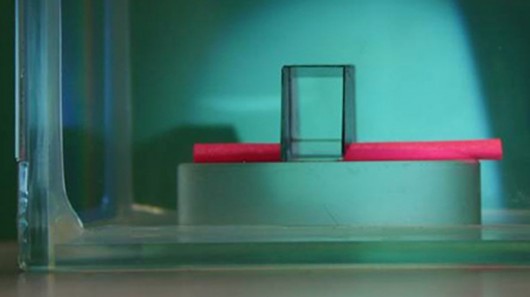
Part of the pink object is rendered invisbile to the naked eye under the calcite-based invisibility cloak (Baile Zhang and G. Barbastathis/SMART Centre)
Physicists from the University of Birmingham, with colleagues at Imperial College, London and Technical University of Denmark, have demonstrated an “invisibility cloak” that can hide a three-dimensional object, centimeters in dimension, large enough for the cloaking area to be visible to the human eye.
The scientists have shown that they are able to hide an object that is much bigger than those cloaked by other research groups. Previous studies have demonstrated cloaking by using a metamaterial — a fabricated composite with optical properties not found in nature — that limits the size of the cloaking region. The team from the UK and Denmark have instead used a natural crystal called calcite; a transparent mineral with double-refraction properties, meaning light enters the calcite and splits into two rays of different polarisations travelling at different speeds and in different directions.
This has enabled the team to hide a larger object as the size of the cloaking area is not limited by the technology available, only by the size of the calcite crystal.
The team has been able to cloak larger objects because it has employed a cloaking design that did not require separate material properties, as all the previous works did. The demonstration was performed, both in the air and in a container of liquid, by using two triangular pieces of calcite glued together, placed on a mirror.
Dr Shuang Zhang, lead investigator from the University of Birmingham”s School of Physics and Astronomy, said: “”This is a huge step forward as, for the first time, the cloaking area is rendered at a size that is big enough for the observer to “see” the invisible object with the naked eye.
“By using natural crystals for the first time, rather than artificial meta-materials, we have been able to scale up the size of the cloak and can hide larger objects, thousands of times bigger than the wavelength of the light.”
“Previous cloaks have succeeded at the micron level (much smaller than the thickness of a human hair) using a nano- or micro-fabricated artificial composite material. It is a very slow process to make these structures and they also restrict the size of the cloaking area. We believe that by using calcite, we can start to develop a cloak of significant size that will open avenues for future applications of cloaking devices.”
"
No comments:
Post a Comment